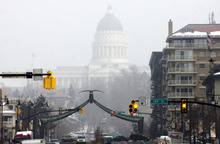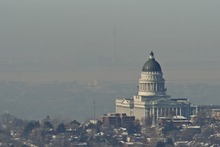This is an archived article that was published on sltrib.com in 2013, and information in the article may be outdated. It is provided only for personal research purposes and may not be reprinted.
Utah regulators on Wednesday approved a long-awaited comprehensive plan for improving winter air quality on the Wasatch Front, where mountain topography and stagnant weather sometimes trap particulate pollution near the ground for days on end.
But relief is still six years away, critics say, long past deadlines set by the Clean Air Act. And even then, improved air quality will barely meet federal standards for fine particulate, or PM2.5.
The Utah Air Quality Board agreed to a few revisions of the draft version of its so-called state implementation plan, or SIP. But it overruled numerous objections raised by industrial polluters and by activists who complained the plan fails to address industry's contributions to Utah's unhealthy air.
The plan is based on modeling that underestimates predicted spikes in fine particulate during winter inversions when valleys are blanketed in smog, according to attorney Joro Walker.
"The SIPs before you today make the decision that the millions of people along the Wasatch Front will — at a minimum — be exposed to air quality that exceeds legal limits for six more years," said Walker, speaking for Western Resource Advocates and various clean-air advocacy groups. "We need SIPs that do more to clean our air and do it more quickly."
Walker insisted the board require that "reasonably available control technologies" be immediately applied to commercial polluters, including retrofits on diesel trucks, rather than waiting or relying on voluntary compliance.
Trucks and cars account for more than half the emissions responsible for the particulate problem, according to the Utah Division of Air Quality. Most of the PM2.5, particles less than 2.5 micrometers in diameter, in the air is not emitted as particles. Instead, it begins as "precursors" such as sulphur dioxide, nitrous oxides and volatile organic compounds that react in the atmosphere.
State officials believe the plan, crafted after years of study and fine-tuning, will get Wasatch Front regions into compliance with federal guidelines by 2019.
In 2006, the U.S. Environmental Protection Agency lowered the 24-hour threshold for ambient levels of fine particulate matter to 35 micrograms per cubic meter of air. A five-county area around the Salt Lake Valley has been officially out of "attainment" since 2009, after three years of missing the new mark, putting Utah at risk of losing federal transportation funding.
PM2.5 embeds deep in pulmonary tissue and has been linked to numerous health risks, including asthma, stroke, heart attacks and poor pregnancy outcomes. It has recently been declared a carcinogen.
"Every year we delay compliance we are condemning tens of thousands of our children to poorer health for the rest of their lives," said Brian Moench, president of Utah Physicians for a Healthy Environment.
Getting the Salt Lake airshed into compliance with the federal PM2.5 rule requires that it violate the 24-hour limit on no more than seven days a year.
On average it now exceeds the 35-microgram limit 18 days a year, or 5 percent of the time.
The air quality board also on Wednesday approved a Utah County plan for PM2.5. A plan for Cache County had been previously approved.
To reduce emissions, the plans depend heavily on federally mandated improvements to automobiles while allowing for 12 percent increases in industrial emissions from "point" sources, such as oil refineries.
"You have to allow businesses to grow if you want to maintain a robust economy and businesses to stay and provide jobs and taxes," said Kyle Bennett, a spokesman for Utah Kennecott Copper.
Under the SIP, Kennecott must trim emissions at its massive Bingham Canyon mine.
"That creates a significant challenge because there is no available control technology that will easily allow us to achieve that," Bennett said. "It requires us to invent or find a technology that will help us achieve that 10 percent reduction from our current permitted emissions by 2019."
The Salt Lake and Utah County plans are collections of control strategies that include recommendations, such as avoiding driving, and regulations, such as restrictions on wood burning. The goal is to reduce emissions of particulate and its precursors by 64.5 tons a day in the five-county Salt Lake area, which includes Weber, Davis and parts of Box Elder and Tooele counties, and by 13.4 tons in Utah County.





